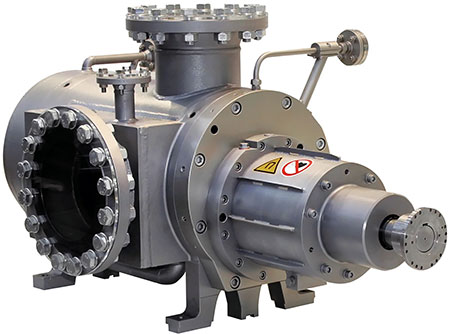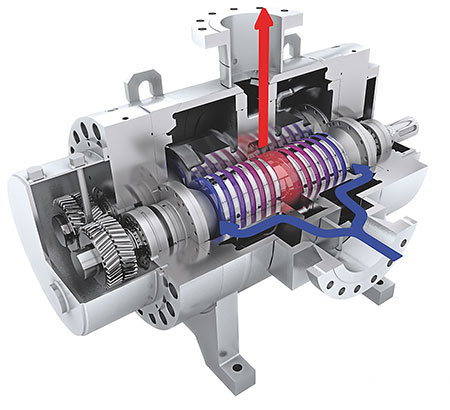
As complexity has grown in processes and new conditions have been added, screw pump technology has attracted increased interest from facility designers, process engineers and operators across the industry.

The need to improve energy efficiency and operating flexibility while driving down operating costs is the main goal. It is time to revisit conventional approaches to pump selection and take a look at the evolution of screw pumps, determine how they could improve economics and safeguard the vitality of critical processes in process plants and transfer systems.
Operating Principles
This article focuses on pump types with multiple screws. All screw pumps are part of the positive displacement family and, as such, are designed to displace flow in direct proportion to the rotary speed of the pump. This runs contrary to hydrodynamic pumps, which rely on kinetic energy.
The tight cavities are formed when the profiles of the screws mesh as the pump rotates, thereby transporting fluids from suction to discharge as it builds up pressure to overcome the downstream back pressure from the system. The screws of the pump are the main pumping elements, where the driven screw or power rotor transfer the torque to one or several idler screws mechanically and hydraulically. The smooth opening and closing pump cavities result in a pump flow with low pulsations and airborne noise.

Most screw pumps are designed to eliminate axial hydraulic thrust either by using balance pistons or by having the screws in an opposed flowing arrangement. The absence of thrust bearings helps to simplify the pump design and eliminate potential wear and maintenance areas.
Applications
Most multiple-screw pump designs are self-priming and can work with low suction pressure. They are also gas tolerant and able to handle free and entrained gases without vapor locking. Low internal fluid velocity and the gentle meshing of the rotors also contribute to low shear rates, which is especially important for shear-sensitive, non-Newtonian fluids as well as different kinds of emulsions.
The operational flexibility of the multiple-screw pump is manifested by its ability to work over a large viscosity range, from light hydrocarbons to residues and emulsions. The screws are normally case hardened for improved wear resistance, and customized coatings are occasionally used to protect rotor bores, the rotor liner and pump casing.
Today’s family of screw pumps includes designs that were traditionally used in hydrocarbon processing. Applications are now increasingly found in the chemical, petrochemical, food and biofuel industries. Each pump design has its specific set of operational advantages and possibilities. Finding the right type of pump for specific applications is not only important for the process but also a cost optimization opportunity including the total cost of ownership.
Designs
Two-screw pumps without timing gears:
One pump design relies on two screws, one drive and one driven idler screw, which are radially supported by bushings and lubricated by the pumped fluid. The bushings are also part of the axial thrust balance configuration where discharge pressure on one side of the journal and suction pressure on the other side creates a pressure balance while providing liquid for lubrication and cooling.
The torque transfer from one screw to the other happens by means of a rolling (as opposed to sliding) contact over the screw profile, providing good wear resistance. These screws are running with radial clearance to the bores, which makes this pump design resistant to abrasive wear and suitable for fluids with low lubricity.
Typical applications of this pump design are with fluids like asphalt, bitumen, pitch, emulsions and oily residues as well as a variety of process fluids like methylenedianiline (MDA) and methylene diphenyl diisocyanate (MDI), biofuels and vegetable oils.

In order to eliminate vapors escaping from the mechanical seal, it can be replaced by a vapor-tight mag drive to eliminate greenhouse gas (GHG) releases. It is often a good alternative to the timed twin-screw pump.
The simplicity and ruggedness without timing gears and only one shaft seal make this pump type easier to service and operate.
Three-screw pumps:
The three-screw pump is used in a number of applications where the fluids range from lube oil in lubrication systems to process fluids like pitch, asphalt and light end products, such as condensate and vacuum gas oil (VGO). The most common pump execution used in process applications has a pumping cartridge (separate from the casing) to allow for different installation options. This design uses one driven screw called the power rotor, which is doing the major pump work and is surrounded by two idler rotors. They merely serve as rotating seals for the power rotor and are handling the radial forces supported by long journals formed by the rotor bores. Similar to the other screw pump designs, the thrust load is hydraulically balanced without the use of thrust plates or bearings. The design also allows for higher speed, which results in high volumetric efficiency, even at higher pressure and low viscosity fluids. Typical three-screw pumps can provide flow rates up to 2,000 gallons per minute (gpm) with a maximum discharge pressure of 2,500 pounds per square inch (psi).
Many pump manufacturers use a cartridge design, which works for customized installations. The outer casing can be designed so it matches the envelope of an existing pump and can be a direct replacement without changing pipe connections or the driver. By taking advantage of the flexibility of a cartridge design, important process improvement is possible as shown in Image 4.
New process conditions are met by having the pump inlet directly bolted to a suction box. The inlet section of the screws is cut open and can act as an auger “pulling” the fluid into the pump.

For light ends, the three-screw pump offers several advantages. The compact and short design, compared to the commonly used horizontal electrical submersible pump (ESP), makes it notably smaller and less heavy for the same differential pressure. The internal hydraulic thrust balancing eliminates the need for the thrust bearing arrangement and its lubrication system, which is required for the ESP. In addition, the pump is gas tolerant and can handle liquids that are gas entrained without vapor locking or losing suction. It also runs smoothly and quietly outside
and is not affected by any critical speed ranges. It is also not prone to surging or pressure pulsations.
Timed double flow twin-screw pumps:
The most versatile of all types of screw pumps is the timed twin-screw pump. Although some manufacturers offer programs with standardized twin-screw pumps, they are often customized for a particular fluid, installation and service. They are designed for larger flow capacities than most other screw pumps and can also be designed for high-discharge pressure. They are used with a large number of different fluids, from nonlubricating, low-viscosity fluids to high viscous heavy oils, bitumen and molasses. Typical twin-screw pumps can cover flow rates up to 6,500 gpm with pressures up to 1,500 psi.
Because the screw profiles rotate without axial and radial contact, the pump is independent of the lubricity of the pumped fluid. However, at a lower viscosity the internal clearances increase the internal slip which is a disadvantage for the volumetric efficiency. The opposite happens when the viscosity increases, the slip decreases and the pump becomes more volumetrically efficient. The double suction flow neutralizes the axial hydraulic force, and the rotors are positioned axially in a bearing arrangement where the radial load is the dominant load.
The twin-screw pump design is widely used in oil fields, refineries, tank terminals, pipelines and chemical plants. As the screws rotate contactless, the flexibility is almost endless when it comes to the nature of fluids it can handle. With variable speed control, a wide flow range can be covered, allowing flow and pressure to stay at a preset level along with low inlet pressure and entrained gas. Polymer emulsion transfer in chemical plants, blending and charge applications in refineries are good process examples. Another of these is the flare knockout drum pump.
The variable pump speed controls the liquid level in the drum, and vapor carry under does not vapor lock the pump as it would with a conventional vertical can pump. The low amount of net positive suction head (NPSH) the pump requires eliminates the pit necessary with a centrifugal pump. The precise flow control is an important aspect in pipeline service where variations in flow can be easily managed by variation of pump speed.
As shown with the types of screw pumps presented, there is almost always a good fit for a particular pumping installation. The widening use of screw pumps is a testament to the versatility and appreciation this type of pump encounters in the marketplace. The development never stops, and recently, new designs for sanitary applications have reached the market. The fundamental characteristics of a screw pump lend themselves to new fluid handling challenges, and we will continue to see new designs being presented to satisfy new demanding pumping requirements.

